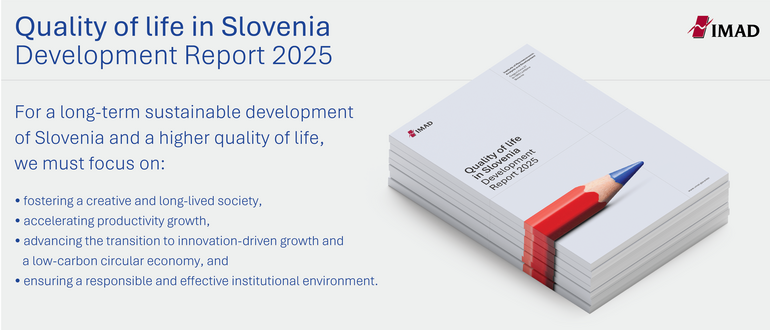Quality of Life in Slovenia – Development Report
Quality of life in Slovenia – Development Report 2025
Slovenia ranks in the top half of EU Member States on most global composite indicators of quality of life.
In the area of social development, the gap between Slovenia and the EU in terms of the population's material well-being has narrowed in recent years, alongside positive developments on the labour market. Income, wealth and wage inequality remain among the lowest in the EU, as do the AROPE rate and the at-risk-of-poverty rate, despite increases in the period 2022–2024. The Slovenian population is relatively well educated. Although youth literacy has declined, it remains above the EU average, while youth creativity continues to rank among the lowest in the EU. The number of healthy life years is well above the EU average, and several other health indicators have also improved. However, significant unmet needs for healthcare and long-term care persist.
The environmental impact of production processes and lifestyles, as measured by the ecological footprint, is comparable to the EU average. The conservation of natural resources is relatively good: watercourses are of the highest quality in the EU, soil quality is satisfactory, while air quality is somewhat impacted, mainly by particulate matter. Slovenia’s diverse and varied landscape supports a high quality of life, but certain changes, such as intensive infrastructure and building construction in rapidly developing areas and the abandonment of land use in remote rural areas, are not conducive to balanced spatial development.
Following the pandemic and energy crisis, Slovenia has maintained economic stability. It has successfully curbed inflation, improved public finances, and kept unemployment at historically low levels. The pace of convergence in GDP per capita in PPS (a measure of economic development) with the EU average accelerated slightly in 2022 and 2023 (following a slowdown during the pandemic), but stalled in 2024. The main driver of this gap remains below-average labour productivity, which reached 85% of the EU average in 2023 and 2024. Given the already high employment rate, further productivity growth is essential to narrowing the economic development gap with more advanced countries and thus also to improving overall quality of life.

